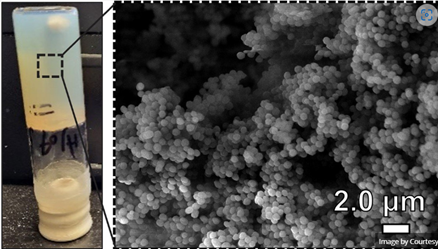Innovative Gel-Filter for PFAS Removal from Water

Long-term exposure to PFAS is associated with health risks. As traditional water treatment methods struggle to effectively remove these contaminants, innovative filtration solutions are becoming increasingly urgent.
PFAS (per and poly-fluoroalkyl substances), often called “forever chemicals,” are synthetic compounds in many consumer products. They are highly resistant to environmental degradation, leading to global contamination of water supplies.
You can also read: How does the PFAS ban affect the plastics industry?
As global concerns about PFAS contamination in water sources grow, a study revealed that 69% of groundwater samples worldwide exceed Health Canada’s safe drinking water criteria for PFAS. Researchers have introduced polymer filtration mechanisms designed to efficiently remove PFAS from drinking water to address this alarming issue.
Advanced Polymer Chemistry for Effective PFAS Removal
Researchers at the University of Massachusetts Lowell, led by Dr. David Reuther, have developed a groundbreaking gel filtration medium designed to tackle PFAS contamination. This technology aims to offer a more efficient and sustainable water purification solution, addressing the shortcomings of existing methods.
How the Gel Works

The gel, displayed on the left, eliminates PFAS by trapping the chemicals in naturally formed voids, as depicted in the microscopic image on the right. Courtesy of UMass Lowell University.
The gel incorporates special polymers that selectively bind to PFAS molecules. As water passes through the gel, the polymeric structure attracts and traps the PFAS compounds, efficiently reducing their levels in the treated water. Still, users can regenerate the gels by washing them with a simple solvent, allowing for repeated use without significant loss of effectiveness. This process not only ensures effective filtration but also promotes sustainability through the reusability of the gel.
Advantages of the New Filtration Technology
The gel-based filtration medium offers advantages, including PFAS removal and providing a comprehensive purification solution. It minimizes environmental impact compared to conventional methods that use harsh chemicals, highlighting its sustainability. Additionally, its scalable technology allows adaptation for various water treatment needs, from small community systems to large municipal plants. The technology’s scalability ensures it can be adapted for various water treatment needs, from small community systems to large municipal plants.
Potential Impact on Public Health
Implementing new filtration technologies to remove PFAS from drinking water can significantly reduce health risks, including cancer, liver damage, and immune system disorders. By effectively eliminating PFAS from water supplies, communities can lower their exposure and thus mitigate associated health problems. Additionally, continuous monitoring and stricter regulations on PFAS usage can help prevent future contamination. Furthermore, PFAS exposure impacts development and reproduction, causing complications like preeclampsia in pregnant women and developmental issues in children, such as lower birth weights and early puberty. Moreover, these chemicals act as endocrine disruptors, leading to hormone imbalances critical for metabolism and growth.

Im looking for gel filters for big blue to remove pfas what is the flow rate per hour so i can see how many i need